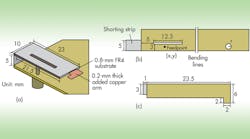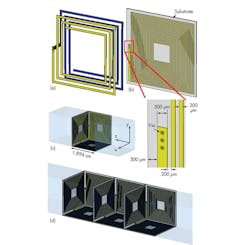This file type includes high resolution graphics and schematics when applicable.
As more is invested in techniques for relaying power wirelessly, research into boosting the efficiency of wireless power transfer (WPT) is increasing as well. One area being explored is the use of optical-lens concepts for radio and microwave frequencies. Materials with a permeability of -1 or permittivity of -1 have the ability to change the dispersion pattern of an antenna’s radiation or focus it. These metamaterials, which are called superlenses, are used in many applications ranging from magnetic-resonance-imaging (MRI) resolution enhancement to WPT. The design and implementation of such a lens has been reported by a research group from Duke University including Guy Lipworth, Joshua Ensworth, Kushal Seetharam, Da Huang, Jae Seung Lee, Paul Schmalenberg, Tsuyoshi Nomura, Matthew S. Reynolds, David R. Smith, and Yaroslav Urzhumov.
The superlens is constructed of a multilayer wine-crate-style lattice, which is composed of PCB-based coils. In an experiment with three layers of resonant coils, power transfer was increased by 15 to 30 dB for distances of 8 to 24 cm. These distances are four to 12 times greater than the diameters of the non-resonant transmitting and receiving coil antennas. The group claims that the numerical simulations and experimental simulations coincide. In addition, the resonant array with negative permeability supposedly enhances the near-field efficiency of the quasi-static magnetic fields. See “Magnetic Metamaterial Superlens for Increased Range Wireless Power Transfer,” Scientific Reports, Jan. 2014, p. 3642.
This file type includes high resolution graphics and schematics when applicable.


